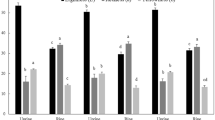Abstract
It is established that the sum total of carotenoids and their components in the full biological ripeness stage of sweet pepper fruits depends both on the variety and on growing conditions. With small-volume hydroponics as compared to a plastic film greenhouse, 34.7–96.5% more carotenoids are accumulated depending on the variety.
Similar content being viewed by others
References
Kanner, J., Harel, S., Palevitch, D., and Ben-Gera, I., Color Retention in Sweet Red Paprika (Capsicum annuum L.) Powder as Affected by Moisture Contents and Ripening Stage, J. Food Technol., 1977, no. 12, pp. 59–64.
Harkay-Vonkler, M., Storage Experiments with Raw Material of Seasoning Paprika with Particular Reference to the Red Color Pigment Components, Acta Alim. Acad. Sci., 1974, no. 3., pp. 239–249.
Reeves, M.J., Re-evaluation of Capsicum Color Data, J. Food Sci., 1987, no. 52, pp. 1047–1049.
Levy, A., Levy, T.S., Elkind, Y., Menogem, E., Barzilai, M., and Kanner, J., Carotenoid and Vitamin C and Vitamin E contents in isogenic chlorophyll and color mutants of paprika (Capsicum annuum L.), 10th Eucarpia Meeting on Genetics and Breeding of Capsicum and Eggplant, Avignon, 1998, pp. 257–260.
Hurtado-Hernandez, I.H. and Smith, P.G., Inheritance of Mature Fruit Color in Capsicum annuum L., J. Heredity, 1985, vol. 76, pp. 211–213.
Shifriss, C. and Pilovsky, M., Studies of the Inheritance of Mature Fruit Color in Capsicum annuum L., Euphytica, 1992, vol. 60, no. 2, pp. 123–126.
Atkins, W.R.G. and Sherrard, G.P., The Pigments of Fruits in Relation to Some Genetic Experiments of Capsicum annuum L., Sci Proc. R. Dublin Soc. N.S., 1915, vol. 14, pp. 328–335.
Deshpande, R.B., Studies in Indian Chilies: 3. The Inheritance of Some Characters in Capsicum annuum L., Indian J. Agr. Sci., 1933, no. 3, pp. 210–300.
Pochard, E., Description des trisomiques de Piment (Capsicum annuum L.) obtenus dans la descendance d’une plante haploide, Ann. Amelior Plantes, 1970, vol. 20, pp. 233–256.
Pochard, E., Localization of Genes in Capsicum annuum L. by Trisomic Analysis, Ann. Amelior Plantes, 1977, vol. 27, pp. 255–266.
Metod vizual’nogo titrovaniya askorbinovoi kisloty: AOASB (Method of Visual Titration of Ascorbic Acid: AOASB), 1996.
Alfthan, G., A Micromethod for the Determination of Selenium in Tissues and Biological Fluids by Single-Test-Tube Fluorimetry, Anal. Chim. Acta, 1984, vol. 65, pp. 187–194.
Author information
Authors and Affiliations
Corresponding author
Additional information
Original Russian Text © V.F. Pivovarov, M.I. Mamedov, O.N. Pyshnaya, N.A. Golubkina, E.A. Dzhos, and E.S. Belavkin, 2009, published in Doklady Rossiiskoi Akademii Sel’skokhozyaistvennykh Nauk, 2009, No. 6, pp. 23–24.
About this article
Cite this article
Pivovarov, V.F., Mamedov, M.I., Pyshnaya, O.N. et al. Content of biologically active substances in sweet pepper fruits under various growing conditions. Russ. Agricult. Sci. 35, 387–389 (2009). https://doi.org/10.3103/S106836740906007X
Received:
Published:
Issue Date:
DOI: https://doi.org/10.3103/S106836740906007X




